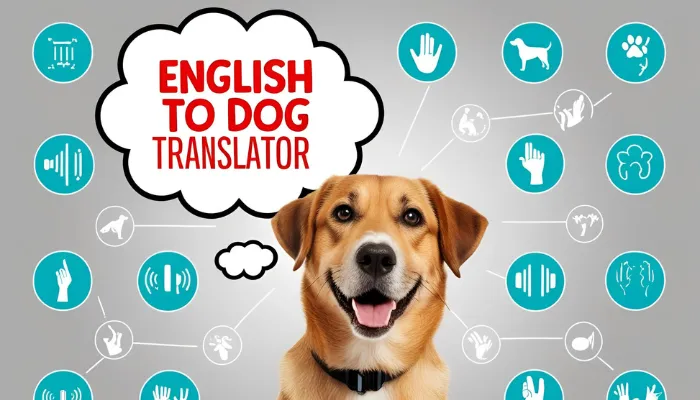English to dog translator applications promise to connect speech to a dog’s bark, but the reality is far more complicated. A DogWhistles translator sounds promising, but most of these apps are designed for entertainment purposes rather than translation. An English to dog bark translator will bark like a dog, but communication is much deeper than sounds; It involves tone and gestures.
APPs alone cannot teach a dog commands; everything relies on repetition. Using an app may be entertaining to some, but in the end, it does not get the job done as most experts agree translators struggle to understand a dog’s feelings. So are these tools effective or just a marketing package?

English To Dog Translator: How Does It Work?
An English to dog translator attempts to bridge the gap between human speech and canine communication. These apps analyze sounds, match patterns, and generate dog-like responses. While intriguing, true translation remains complex due to the vast differences in language structure.
An English to dog translator is typically an app or device designed to analyze sounds and match them with predefined patterns. Here’s how they function:
- Speech Recognition: Recognizes and transfers spoken words into written text or audio waves.
- Sound Analysis: Compares human words with a database of canine vocalizations.
- Predefined Translations: Matches human phrases with common dog sounds or behaviors.
- Bark Interpretation: Some claim to analyze pitch, frequency, and tone of barks.
While dogs comprehend and communicate using body language and some vocal sounds which AI tries to interpret, the work becomes mind-bogglingly challenging due to the intricate features of human speech.
Can Dogs Understand Human Words?
Of course! Dogs often respond to common words and phrases, although their comprehension isn’t quite holistic. Here’s what the data indicates:
- Dogs process language differently than humans.
- They rely on tone and body language more than words.
- Most dogs recognize around 165 words, with highly trained ones knowing over 1,000.
While an English to dog translator might help mimic familiar sounds, true two-way communication remains a challenge.

The Science Behind Dog Communication
An English to dog translator claims to decode canine speech, but dogs communicate in more complex ways. Barks, growls, and body language convey emotions beyond words. Understanding these signals builds a stronger connection with your pet.
How Do Dogs Communicate?
Dogs express themselves through combining barking, growling, whining, body language, and scent marking. Here’s how it works:
| Communication Method | Meaning |
|---|---|
| Barking | Alert, excited, or distressed. |
| Growling | Warning, playful, or in pain. |
| Whining | Seeking attention, anxious, or in pain. |
| Tail Wagging | Happy or angry (depends on the position). |
| Ear Position | Forward = Interested, Back = Frightened, Submissive. |
| Posture | Calm = Relaxed stance, Aggressive/alert = Stiff stance. |
Since dog communication is multi-faceted, translating it into words is complex.
Understanding English to dog translator tools can help interpret your pet’s emotions. Every bark, wag, or posture carries a message. Recognizing these cues strengthens the bond with your dog.
Popular English to Dog Translator Apps & Devices
An English to dog bark translator promises to decode canine speech, but do these apps really work? Many dog translator apps claim to decode barks, but most are for entertainment rather than science. Understanding your dog’s natural communication remains the best approach.
Several English to dog translator apps claim to decode canine speech. Let’s explore some of the most popular ones:
1. Dog Translator Simulator
- Claims to translate human words into dog sounds.
- Uses a soundboard with common dog barks.
- Entertainment-based, not scientifically backed.
2. My Talking Pet
- Animates pet photos to mimic speech.
- More of a fun novelty than an actual dog translator.
3. Human-to-Dog Translator
- Mimics dog sounds to elicit reactions.
- Some dogs respond, but no actual translation occurs.
4. Pet Translator – Woof Woof
- Uses pre-recorded dog sounds to engage pets.
- Designed for entertainment, not scientific translation.
Exploring English to dog translator apps adds a fun twist to pet interactions. While these tools mimic canine sounds, they don’t offer real translations. Understanding natural dog communication remains the best way to connect. Every bark and wag tells a story beyond technology.
Discover more tips! Visit our human to dog translator page for a full guide on using it correctly.

Does an English to Dog Bark Translator Actually Work?
An English to dog bark translator promises to decode canine sounds, but does it really work? Dogs communicate through barks, body language, and instincts rather than words. Understanding their signals requires observation, not just technology.
The Limitations of Dog Translators
While an English to dog bark translator may seem exciting, these tools have limitations:
- Dogs Don’t Have a Human-Like Language System
- They communicate using instinctive sounds, body language, and scents.
- Context Matters More Than Words
- Dogs respond to tone, gestures, and environment rather than specific words.
- Barks Are Not Always Predictable
- The same bark can mean excitement, fear, or a warning depending on context.
- Limited Scientific Backing
- Most translator apps are for fun, not actual communication tools.
An English to dog translator may sound useful, but real communication goes beyond apps. Dogs rely on instinct, tone, and context to understand humans. No tool can fully decode a bark without considering emotions. Observing behavior is the key to deeper connections. Understanding your dog starts with paying attention, not technology.
How to Communicate Effectively With Your Dog?
An English to dog translator may sound helpful, but real communication goes beyond words. Dogs understand tone, body language, and consistency more than translations. Strengthening your bond starts with clear commands and positive reinforcement.
Instead of relying on an English to dog translator, try these proven communication techniques:
1. Use Consistent Commands
- Dogs learn more effectively when commands are easy and repetitive.
- Use words such as “sit”, “stay”, “come”.
2. Observe Body Language
- Pay attention to ears, tail, eyes, and posture.
- A stiff body may indicate alertness or fear.
3. Reward-Based Training
- Treats and other forms of positive stimulus, such as praise, can be used for desired behavior.
- Attempts at schooling through punishment should not be done as it results in mistreatment of the subject.
4. Speak in a Calm Tone
- Dogs are sensitive to voice pitch and emotion.
- High-pitched voices often indicate excitement or friendliness.
An English to dog translator can’t replace real communication with your pet. Clear commands and consistent tone build trust and understanding. Observing body language reveals more than any app can. Positive reinforcement strengthens your bond without confusion. True connection comes from patience, not technology.
What Experts Say About Dog Translators?
An English to dog translator may seem useful, but experts remain skeptical. Dogs don’t process language like humans; they rely on tone and context. Understanding their behavior matters more than any translation device.
Animal behaviorists and scientists remain skeptical about English to dog translator apps and devices. Here’s what they emphasize:
- According to Dr. Stanley Coren, a dog specialist, dogs do respond to phrases, but they do not understand speech in the same way humans do.
- Dr. John Bradshaw, an anthrozoologist articulates, that there are differences in barks as there are in speech, which means that the interpretation of barking will depend on the species, situation, and the creature’s character.
- Most experts agree that dogs can follow instructions and engage with the animal but it is other than needing a translation device.
Experts agree that an English to dog translator isn’t a true communication tool. Dogs respond to tone, context, and familiarity rather than direct translations. Every bark carries meaning, but understanding depends on observation. Training and interaction build a stronger bond than any device. Real communication happens through trust, not apps.
Future of Dog Translation Technology
While current English to dog translator tools lack accuracy, advancements in AI and machine learning may change that. Potential developments include:
- Better voice recognition for different dog breeds.
- AI models trained on real dog behavior research.
- Wearable devices detecting emotional states.
Though we’re far from true dog-human conversation, future technology might bridge the gap in meaningful ways.
FAQs on English to Dog Translators
Curious about English to dog translator? These FAQs break down how they work, their limitations, and whether they truly help communicate with dogs.
1. Are English to dog translators effective?
Most are created for profit and lack any useful techonlogy involving the mutt’s communication.
2. Do dogs recognize human speech?
Dogs seem to pick up more of the tone and body language than the trainer does, but a well-trained dog can understand up to 1,000 words.
3. What are some instincts that dogs have?
Dogs bark, growl, whine, and use their tails, ears and body in different positions and movements to feel and show emotions.
4. Are dog translators apps and programs scientifically accurate?
None of these systems work, as validation isn’t consistently accurate. Most of these systems attempt to use AI and pretrained sounds as translation which is inefficient.
5. How does one attain the greatest efficiency in communication with a dog?
Strongly reinforces the commands as well as watching their body language and talking using praises- which helps in association.
While dog translators sound exciting, real communication relies on tone, body language, and training. No app replaces the bond built through observation and interaction.
Conclusion
Having an English to dog translator earmarks a lot of feasibility for animal lovers, but at present, it functions for more as a gimmick than a means of communication. While some apps do bark like dogs, they don’t truly interpret canine speech. A real dog bark to English speech machine would require sophisticated AI that gets context, body form, and tone of speech. Instead of devices, pet owners should emphasize training adequately, as well as watching their dogs. The existence of a dog translator is intriguing, however, will have to wait a while longer to fully understand our furry friends.
